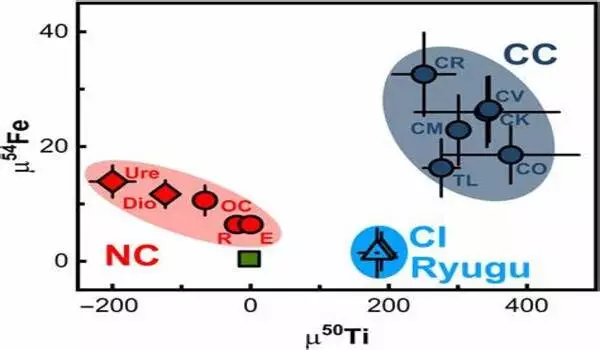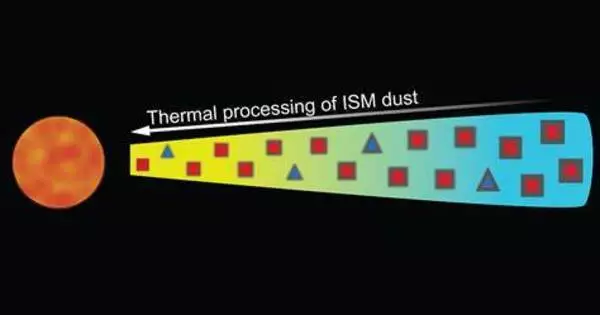According to a multinational study led by researchers from Tokyo Tech, the observed variations in chromium (Cr) isotope ratios in the Ryugu asteroid samples collected by Hayabusa2 likely resulted from elemental redistribution of slightly soluble Cr by water within the parent body. The findings add to our understanding of the origin and evolution of materials in our solar system.
The Japan Aerospace Exploration Agency’s (JAXA) Hayabusa2 space mission returned home with samples from the asteroid Ryugu, which orbits the Sun between Earth and Mars. Preliminary chemical analysis of Ryugu samples revealed that the asteroid is rich in volatile and organic-rich materials, similar to the class of meteorites known as Ivuna-type carbonaceous chondrites (CIs). Such asteroids have gained the attention of scientists due to their close chemical resemblance with elemental environments during the birth of the solar system.
Studies have shown that isotopic anomalies in chromium (54Cr/52Cr) and titanium ratios (50Ti/47Ti), often expressed as ε54Cr and ε50Ti, respectively, can help decipher the nucleosynthetic origins of chemical components in extraterrestrial materials.
Previous research on asteroid samples established that Ryugu and Ivuna-type carbonaceous chondrites formed in a common location; a more distant part of the solar system than other meteorite parent bodies.
Professor Tetsuya Yokoyama
While the isotopic variability of other elements in bulk Ryugu samples is similar to that in CIs, anomalies in Cr isotopes are slightly different from those recorded in the literature. To unravel the origin of these deviations, an international team of scientists led by Professor Tetsuya Yokoyama from Tokyo Institute of Technology has recently investigated ε54Cr and ε50Ti in five different Ryugu samples. Their results have been published in Scientific Advances.
“Previous research on asteroid samples established that Ryugu and Ivuna-type carbonaceous chondrites formed in a common location; a more distant part of the solar system than other meteorite parent bodies.” However, the slight difference in Cr isotopic anomalies between Ryugu and CIs raised the question of whether the heterogeneity is due to the difference in birth place, or if it is the result of secondary processes that occurred after the accretion of their parent bodies,” Prof. Yokoyama explains.
The team chose two Ryugu samples from the first touchdown and three from the second touchdown site for precise analysis of the Cr and Ti anomalies. After acid digestion, the samples were subjected to inductively coupled plasma mass spectrometry and thermal ionization mass spectrometry.

The test results in samples weighing less than 24 milligrams indicated that the variation in ε50Ti is marginal and agrees with the data available on CIs. The same was not true for ε54Cr values, where the dispersions exceeded formerly reported values for CIs. However, when the sample was greater than 90 milligrams, isotopic similarity was found. This observation suggested that Cr isotopes are not uniformly distributed in the Ryugu parent body at the microscopic level, while Ryugu has a Cr isotopic composition similar to CIs at the macroscopic level, thus corroborating the idea that Ryugu and CIs share a common genetic heritage.
Further examination of the samples revealed that the microscopic heterogeneity in Cr isotope distribution resulted from the physicochemical fractionation of 54Cr-rich presolar nanoparticles and Cr-bearing secondary minerals. This phenomenon was attributed to asteroid aqueous alteration. The water in the asteroid dissolved the mildly soluble Cr while undissolved 54Cr-rich presolar nanoparticles circulated the 54Cr-depleted fluid within the body, resulting in the precipitation of secondary minerals depleted in 54Cr. The team’s analysis of radiogenic isotope 53Cr revealed that secondary mineral precipitation occurred around 5.2 million years after the birth of the solar system.
Nucleosynthetic 54Cr anomalies in extraterrestrial materials are frequently linked to nebular origins, but this study shows that apparent 54Cr variations in asteroidal materials could also result from parent body processes like elemental redistribution by water.
“Unlike meteorites that fall to Earth from space, Ryugu samples are unaffected by terrestrial contamination, and they are especially valuable for unraveling the solar system’s early history because they retain primitive chemical characteristics.” As a result, Prof. Yokoyama concludes, “this study brings us one step closer to fully understanding our chemical past.”





